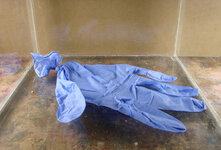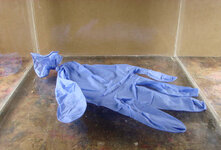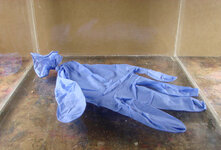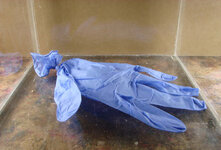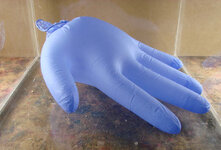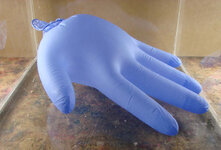MesquiteMan
Retired Head Moderator
A while back I took some pictures of some blanks being stabilized. I took the pics at 25" Hg, 27" Hg, and 28.5" Hg at 1,000+/- feet above sea level to show the difference in the amount of bubbles from each vac level. Some folks say that 25" Hg at sea level is enough for good stabilization. I disagree.
The idea behind vacuum stabilizing is to remove as much air from the blank as possible, thus making room for the stabilizing resin to be "sucked" back into the blank when the vacuum is released. At sea level, a 25" Hg vacuum is only removing 85% of the air from the blank. Is that enough? Most likely it will do a descent job but higher vacuum will remove more air, thus allowing more room for additional resin to be infused into the blank.
Here are some pictures I took this evening from an interesting experiment to show just how much difference there is between an 85% vacuum and a 99% vacuum. I took a regular nitrile shop glove and tied it off with no apparent air in the glove. I then placed it in my vacuum chamber and took pictures at different vacuum levels. I held the vacuum at the particular level for 15 minutes BEFORE I took the picture to make sure it had "inflated" as much as it was going to. Remember, I am at around 1,000' above sea level so my maximum theoretical vacuum is 28.92" Hg since you loose 1" of mercury on the gauge for every 1,000' above sea level.
Here is the glove at atmospheric pressure:

Here is the same glove at 20" Hg:

25" Hg:

26" Hg:

27" Hg:

28" Hg:

28.5" Hg:

And finally, an animated gif with all of the photos in sequence to show what is happening:

If course if this was a pen blank, the air would be coming out of the blank as bubbles and rising to the surface. You can see there is a huge difference in the amount of air expansion between 25" Hg and 28.5" Hg. Remember, the more air you can get out of the blank, the more resin you can get in!
The idea behind vacuum stabilizing is to remove as much air from the blank as possible, thus making room for the stabilizing resin to be "sucked" back into the blank when the vacuum is released. At sea level, a 25" Hg vacuum is only removing 85% of the air from the blank. Is that enough? Most likely it will do a descent job but higher vacuum will remove more air, thus allowing more room for additional resin to be infused into the blank.
Here are some pictures I took this evening from an interesting experiment to show just how much difference there is between an 85% vacuum and a 99% vacuum. I took a regular nitrile shop glove and tied it off with no apparent air in the glove. I then placed it in my vacuum chamber and took pictures at different vacuum levels. I held the vacuum at the particular level for 15 minutes BEFORE I took the picture to make sure it had "inflated" as much as it was going to. Remember, I am at around 1,000' above sea level so my maximum theoretical vacuum is 28.92" Hg since you loose 1" of mercury on the gauge for every 1,000' above sea level.
Here is the glove at atmospheric pressure:
Here is the same glove at 20" Hg:
25" Hg:
26" Hg:
27" Hg:
28" Hg:
28.5" Hg:
And finally, an animated gif with all of the photos in sequence to show what is happening:

If course if this was a pen blank, the air would be coming out of the blank as bubbles and rising to the surface. You can see there is a huge difference in the amount of air expansion between 25" Hg and 28.5" Hg. Remember, the more air you can get out of the blank, the more resin you can get in!
Attachments
Last edited:

